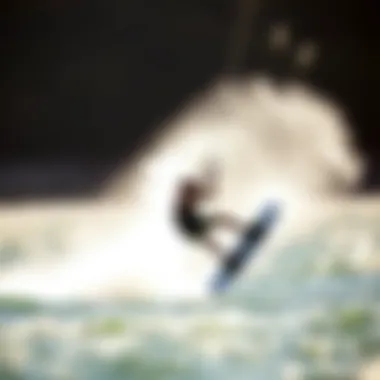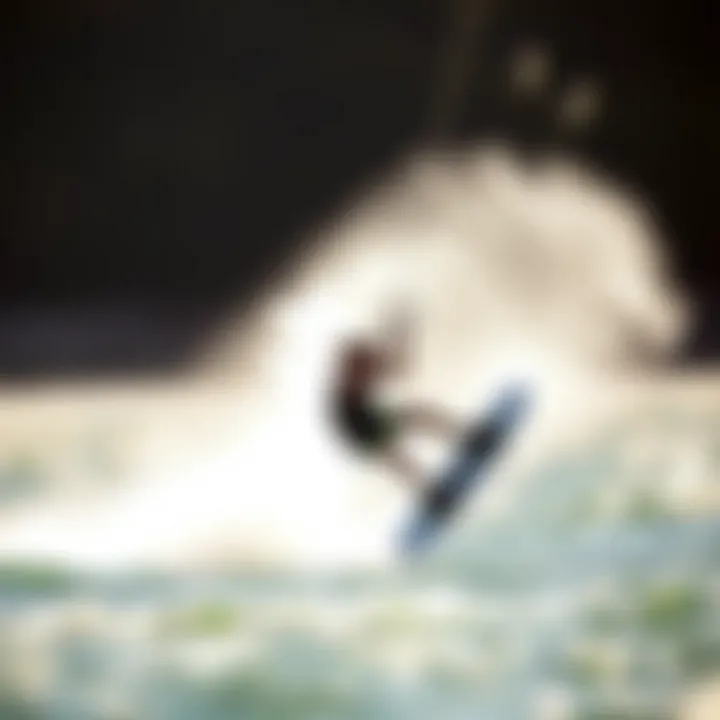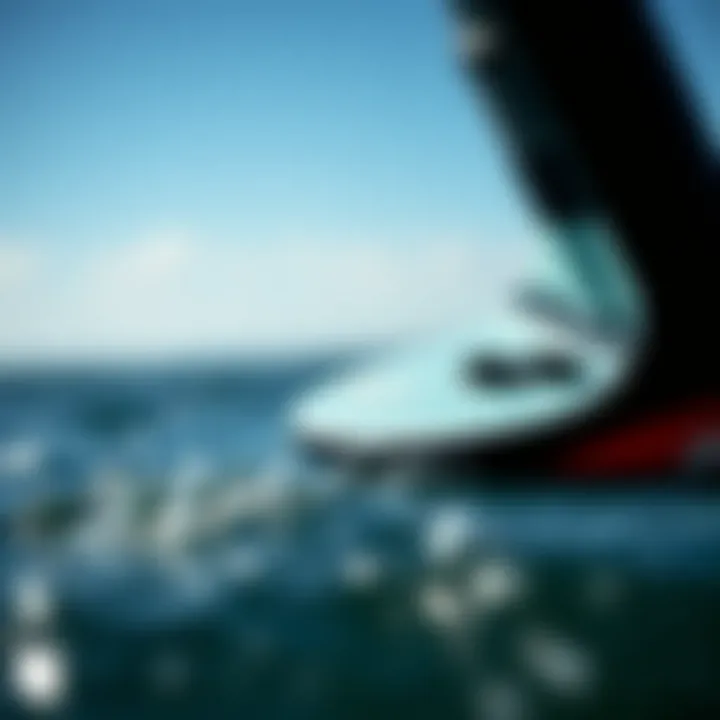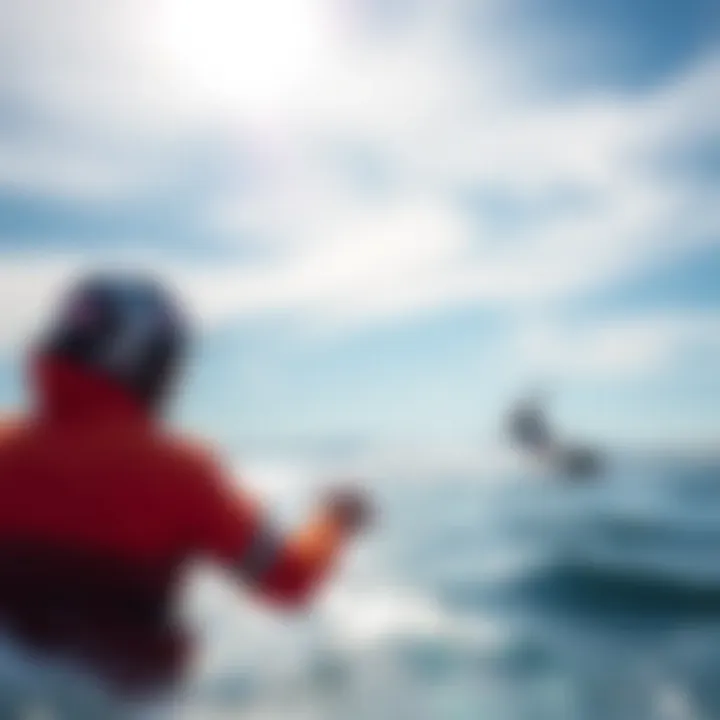In-Depth Look at Liquid Force Foil Innovations


Intro
In the world of kiteboarding, staying on the cutting edge of equipment can significantly transform your experience and performance on the water. The Liquid Force Foil represents a leap in technology and design, appealing to seasoned riders and novices alike. Whether you’re navigating powerful winds or gliding gracefully across flat waters, understanding this gear is crucial for maximizing your adventure on a kiteboard.
This article aims to dissect the essential components of the Liquid Force Foil, exploring the mechanics that make it an exciting choice for kiteboarders seeking speed, agility, and stability. We will delve into the technical innovations that set these foils apart, examine their design features that enhance performance, and assess real user experiences. By the end, readers will be prepared not only to choose the right foil for their needs but also to learn how to maintain it for optimal performance throughout its lifespan.
Let's embark on this journey to discover the ins and outs of Liquid Force Foil and how it can elevate your kiteboarding experience to new heights.
Preamble to Liquid Force Foil
In the competitive arena of kiteboarding, the right gear can make all the difference. When it comes to performance and maneuverability, Liquid Force Foil stands out as a beacon of engineering excellence and thoughtful design. Understanding what makes these foils tick is essential for riders hoping to elevate their skills and drastically enhance their kiteboarding experience.
Liquid Force Foil is not just another piece of equipment; it represents a significant leap in how kiteboarding is approached. The design intricacies of these foils allow for smoother rides, increased lift, and more control in various water conditions. Riders who invest time learning the nuances of these foils often find themselves experiencing a new level of freedom—the sensation of gliding above the water, with minimal resistance.
Key considerations when exploring Liquid Force Foil include:
- Benefits of Foil Technology: Switching from traditional boards to foils can feel like trading a bicycle for a motorcycle. The sheer thrill of speed and agility becomes apparent once you discover how these advanced designs interact with the water.
- Adaptability to Conditions: Whether it's flatwater or choppy waves, these foils adapt seamlessly, giving the rider an edge. It's this versatility that attracts kiteboarders from various backgrounds, whether they’re racing or simply enjoying a leisurely ride.
- Learning Curve: While the idea of foiling can intimidate at first, understanding its technology and setup plays a crucial role in mastering the sport. Taking the time to learn how Liquid Force Foils operate will pay dividends in performance.
Ultimately, getting acquainted with Liquid Force Foil doesn't merely enhance one’s experience; it can redefine what riders believe is possible on the water. As we delve further into the innovations and intricacies inherent in these foils, it becomes clear that they are more than tools—they are gateways to the next level of kiteboarding adventures.
"Embracing new technology is like shedding old skin; it may feel strange at first, but the results are undeniably freeing."
With this foundation laid, we now embark on a more detailed exploration of the historical context that set the stage for the development of Liquid Force Foil.
Historical Context
Understanding the historical context of Liquid Force Foil is crucial to grasp how kiteboarding equipment evolved, leading to the sophisticated designs we see today. This section sheds light on the journey of kiteboarding, especially how advances in technology, materials, and techniques gave birth to foils as we know them. It provides a backdrop against which the innovations and performance criteria of Liquid Force Foil can be appreciated.
Evolution of Kiteboarding Equipment
The metamorphosis of kiteboarding equipment is a tale threaded with ingenuity and perseverance. When this sport first took off in the late 20th century, kiteboards were rudimentary—think windsurfing boards modified to accommodate kites. Early adopters braved choppy waters and stiff breezes with little understanding of the forces at play.
As the years passed, manufacturers began to experiment. Innovations like depowerable kites and lightweight materials changed the game entirely. Kiteboards, initially bulky and heavy, started being trimmed down, making them more nimble and easier to control. Liquid Force, among other pioneers, started to push boundaries, crafting boards that not only floated but soared, complementing the kite's power with advanced designs.
The advent of foiling in kiteboarding marked another significant leap. Before foils, riders were limited by water resistance, relying on their boards to skim across the surface. The introduction of foils allowed them to rise above the waves, changing their interaction with the water. The lift created by the hydrofoil transformed the ride, allowing for smoother, faster, and more dynamic movements. This breakthrough compounded the evolution of kiteboarding equipment, turning it into a sport that tests skill and creativity.
The Emergence of Foils in the Sport
Foils began to carve their niche in the kiteboarding community in the early 2000s. At first glance, these were merely an addition; however, they soon proved to be a game changer. Kiteboarders quickly realized that foils offered unique advantages, such as reduced drag and improved lift, which made riding conditions more versatile.
In 2015, Liquid Force launched their first foils, which were targeted towards a spectrum of riders, from beginners to seasoned professionals. This inclusion made foiling more accessible, as it bridged the gap between traditional kiteboarding and this innovative extension.
The rise of foils also opened up new realms for exploration. With a greater ability to cut through lighter winds, kiteboarders found opportunities to kite in conditions that were previously deemed unsuitable. Moreover, riding foils instilled a sense of freedom—a lightness that was greatly reminiscent of flying, something that seems to resonate deeply with kiteboarders.
As the sport evolved, so did the user expectations, prompting companies like Liquid Force to continuously enhance their designs. The foils became more refined, focusing on aspects like stability, control, and response time, crucial for riders looking to push the limits of their craft.
"The introduction of foils didn’t just enhance performance; it revolutionized the way we interact with water sports, soaring above former limitations and riding waves like never before."
In summation, the journey of kiteboarding equipment has been a remarkable one, moving from simple boards to complex foiling systems. The emergence of foils hasn't just redefined the sport but has invited a new wave of enthusiasts eager to test their skills on the water. With knowledge of the historical context, we can better appreciate Liquid Force Foil's state-of-the-art offerings and their impact on the ever-evolving landscape of kiteboarding.
Understanding Foil Technology
The realm of kiteboarding has seen a significant transformation with the introduction of advanced foil technology. Understanding this technology is critical as it directly influences not only technical performance but also the overall experience for riders at all levels. Foils are engineered to lift the rider above the water's surface, creating a unique sensation that combines speed and smoothness in a way that traditional boards cannot match.
When discussing foil technology, several key elements come into play, such as design principles, materials used, and aerodynamic factors. Each of these aspects contributes to how well a foil performs across different conditions and styles of riding. Kiteboarders today face a choice unlike any before. The right knowledge can optimize their experience on the water.
Basics of Foil Design
Foil design is at the heart of a foil's performance. A foil typically consists of a few essential components: the wing, mast, and fuselage. Each of these components plays a distinct role in how the foil interacts with the water and air.
- Wings: The wings are crucial as they produce lift. Their shape determines how efficiently the foil can cut through the water and rise. Wider wings offer more stability and lift, while narrower ones can enhance speed and agility.
- Mast: The mast connects the wing to the board and can vary in length. A longer mast helps in deeper water conditions but requires more skill to maneuver.
- Fuselage: This part connects the mast to the rear wing, influencing steering and control. The length and design of the fuselage can affect turning radius and responsiveness.


A well-thought-out design can make a considerable difference. Riders can experiment with various configurations to find a combination that suits their style and the specific conditions they encounter.
Materials Used in Liquid Force Foils
The selection of materials in Liquid Force foils is not something to overlook. Different materials have distinct properties that affect durability, weight, and performance.
- Carbon Fiber: Known for its strength and lightness, this material allows for a responsive and agile foil. However, it could be more expensive, which makes it a premium choice.
- Aluminum: A more economical option, aluminum provides a balance between durability and weight. While not as stiff as carbon, it can still perform very well under various conditions.
- Composite Materials: These often combine the best of both worlds, utilizing a mix of materials to achieve a specific performance goal. They can balance weight and strength, providing a versatile option for different riding styles.
Understanding these materials can help riders evaluate which foil fits best for their budget and goals, aligning with the dynamic nature of kiteboarding.
Aerodynamics and Hydrodynamics
Aerodynamics and hydrodynamics are two sides of the same coin. In simple terms, aerodynamics deals with how air interacts with the wings, while hydrodynamics focuses on the water interaction. Both are essential to the performance of a foil, influencing lift, stability, and drag.
- Lift Generation: Lift is created as the foil moves through water. The angle of attack of the wing determines how much lift is generated. Too steep an angle can cause a stall, while too shallow may not generate enough lift.
- Stability: A properly designed foil remains stable even at high speeds or in choppy waters. The shape of the wing, its placement, and the overall design work together to maintain balance and control.
- Drag Reduction: Minimizing drag allows the foil to cut through the water more efficiently. Streamlined designs help achieve this, ensuring that the rider can maintain speed with less effort.
"Choosing the right foil is more than just brands or looks; it’s about understanding how technology can elevate your kiteboarding experience to new heights."
By grasping these technical insights, both seasoned kiteboarders and newcomers can elevate their skill set and enjoy the thrill that Liquid Force foils bring to the sport.
Types of Liquid Force Foils
When venturing into the world of kiteboarding, understanding the different types of Liquid Force foils becomes essential. Each variant serves a specific function and caters to unique preferences and conditions. Selecting the right type can significantly enhance an individual’s experience on the water, allowing for tailored performance that meets the needs of different riders and environments. In this section, we'll break down three primary types of Liquid Force foils: freestyle foils, wave foils, and race foils.
Freestyle Foils
Freestyle foils are designed to support tricks and aerial maneuvers. They typically feature a shorter wingspan and a more responsive feel, making them ideal for riders looking to pull off jumps and spins.
- Benefits:
- Lightweight construction: Freestyle foils utilize materials that reduce weight, such as carbon fiber, allowing for better control and maneuverability in the air.
- Stability during tricks: These foils lend themselves to stability despite the intense movements demanded by freestyle riding.
- Enhanced feedback: Riders often report that these foils provide immediate feedback, improving the learning curve for complex tricks.
However, it’s essential for riders to consider their skill level when choosing a freestyle foil. Novices may find them challenging to handle, while seasoned kiteboarders will appreciate the high degree of responsiveness and performance.
Wave Foils
Wave foils are molded to tackle the adrenaline-pumping thrill of riding waves. These foils are typically more robust and designed to slice through water while maintaining stability.
- Benefits:
- Designed for wave riding: Their shape allows for enhanced lift, translating to smooth glides over chop and more controlled turns when negotiating swells.
- Improved performance in rough conditions: They perform exceptionally well in turbulent waters compared to other types of foils, allowing for a more thrilling ride.
- Rider comfort: Wave foils provide a more stable ride, which is critical when navigating through the unpredictable nature of ocean waves.
Race Foils
Race foils are all about speed and efficiency. Constructed to minimize drag, they have a sleek design that can push boundaries on open water.
- Benefits:
- High-speed capabilities: For those aiming to compete or enjoy fast rides, these foils can reach impressive speeds, providing a thrilling experience.
- Efficient glide: Race foils often require less effort from the rider, allowing for long-distance gliding with minimal fatigue.
- Precision performance: Their design focuses on aerodynamics, making them crucial for competitive kite racing.
The choice of a race foil hinges on the rider’s level of experience, competitive aspirations, and specific conditions in which they plan to ride.
The right foil type not only enhances performance but also impacts the overall enjoyment of your kiteboarding experience. Each variant opens up new possibilities on the water, making informed choices paramount in achieving the best ride.
Overall, the selection of the right Liquid Force foil can significantly map out the trajectory of one’s kiteboarding journey. Riders should consider their style, the conditions they usually encounter, and personal preferences when choosing between freestyle, wave, or race foils. There's no one-size-fits-all; each type finds its rightful place in the diverse canvas of kiteboarding.
Performance Analysis
In the world of kiteboarding, the significance of performance analysis cannot be understated. It serves as the bedrock for understanding how equipment—specifically Liquid Force Foils—can enhance your overall experience on the water. Performance is multifaceted, incorporating speed, maneuverability, stability, and user feedback. When you grasp these components, it becomes much easier to tailor your gear to meet your individual riding style and conditions.
Understanding how these elements influence one another is key. For instance, a foil that offers blistering speed but lacks stability may be exhilarating in calm conditions but can turn treacherous when the wind picks up. Conversely, something more stable might not allow for quick maneuvers needed in freestyle tricks. Therefore, it’s essential to find a balance among them, optimizing for what best suits your needs.


In this section, we’ll dive into three critical points of performance: the foil’s speed and maneuverability, its stability in varied conditions, and real-world user experiences captured through feedback and reviews. Each of these aspects provides valuable insights that can help kiteboarders, instructors, and enthusiasts make informed decisions about their gear, ultimately enhancing the versatility and enjoyment of their kiteboarding adventures.
Speed and Maneuverability
A foil's speed and its ability to maneuver effectively define its performance quality. Liquid Force Foils are designed with a focus on hydrodynamic efficiency, reducing drag as they slice through water. The sleek shape contributes to this speed; sharper edges can deliver quicker take-offs, allowing for exciting rides even in light winds.
"Speed can give you that added rush, but it’s the ability to control that speed that separates the pros from the rookies."
When assessing maneuverability, several factors come into play:
- Wing Shape: Curved wings can allow for tighter turns, while flatter designs may increase speed but reduce agility.
- Aspect Ratio: A higher aspect ratio often means improved speed at the expense of stability, which can be tricky for less experienced riders.
- Weight Distribution: A well-balanced foil ensures that you can shift your weight without losing control, making quick adjustments when needed.
Finding the right balance among these elements can offer you an exhilarating experience on the water, whether you're cutting through waves or making daring maneuvers.
Stability in Varied Conditions
Stability is another cornerstone of performance analysis. Liquid Force Foils strive to maintain their composure across different environments—from glassy lake surfaces to choppy ocean swells. A stable foil will remain predictable when gusts hit, keeping you secure as you ride.
Some key components affecting stability include:
- Surface Area: Larger wings can provide more lift but can also become cumbersome in high winds. A smaller wing, while more nimble, might struggle when the wind is inconsistent.
- Design Elements: Features like V-shaped hulls or reinforced joints can further enhance stability. Some foils even come with adjustable settings, allowing riders to tailor the stability to their preference.
- Rider Skill Level: A seasoned kiteboarder will likely have less need for stability than a beginner who is still learning to handle the basics.
In changing conditions, understanding how your foil reacts becomes crucial, especially in terms of wind and water interplay.
User Experience: Feedback and Reviews
Finally, user experience is a treasure trove of insights that can’t be overlooked. Feedback from fellow riders serves as real-world validation of claims made by manufacturers. It’s common practice to check forums—like those on Reddit—or social media platforms for unvarnished opinions and reviews.
When perusing user feedback, consider these aspects:
- Durability: Many users discuss how well their Liquid Force Foils hold up over time, particularly in saltwater versus freshwater conditions.
- Ease of Use: Newcomers often share how manageable certain models are for their skill level, whereas advanced riders might focus on performance in challenges.
- Overall Satisfaction: An obvious yet crucial point, reflecting on emotional experiences is vital. Riders frequently express their joy or frustrations, sharing the highs of mastering tricks and the lows of equipment failures.
By amalgamating multiple feedback points, potential buyers can ascertain whether a specific Liquid Force Foil aligns with their personal style and needs.
In summation, performance analysis equips kiteboarders with the knowledge they need to select a foil system suited to their riding style and conditions. By taking speed and maneuverability, stability in various conditions, and user experiences into account, individuals can make more informed choices in their pursuit of thrilling water adventures.
Foil Setup and Configuration
Foil setup and configuration are crucial components in maximizing the performance and enjoyment derived from using Liquid Force Foils. When a kiteboarder takes the time to properly set up their foil system, they not only ensure a smoother ride but also enhance the overall functionality of their equipment. Misconfigurations can lead to a range of issues, from decreased stability to performance inconsistencies. Here, we'll explore how making well-informed decisions regarding foils contributes to a more harmonious experience on the water.
Choosing the Right Size and Shape
Selecting the appropriate size and shape of a foil is a pivotal step that directly impacts both speed and maneuverability. For instance, larger foils are typically associated with more lift and better performance in light winds, while smaller foils excel in higher winds where precision control is key.
When considering, it’s also essential to reflect on personal skill level and riding style. A beginner who opts for a smaller foil might struggle with stability, while an advanced user might find a larger foil too cumbersome for tricks. Here’s a breakdown of factors to consider when choosing:
- Rider Experience: Newer riders generally benefit from more stable, larger foils.
- Conditions: Assess the average wind and water conditions you’ll be facing.
- Riding Goals: Are you looking to perform tricks, race, or just cruise? Your goals will shape size choices.
In addition, the shape of the foil can affect its responsiveness. Wider wings provide more lift but may sacrifice some speed, while thinner wings are typically faster but can be trickier to control. Ultimately, it’s about finding the right balance for your unique needs.
Assembling Your Foil System
Assembling your foil system might seem straightforward, but there are intricacies that can dictate the experience out on the water. Take the time to follow each step carefully, as a poorly assembled foil can lead to unexpected gains or losses in performance. Here’s how to ensure everything is set up correctly:
- Read Your Manual: Before diving in, review the instructions provided. Different foils might have specific assembly quirks.
- Connect the Mast and Fuselage: Align the mast with the fuselage, ensuring all connections are secure. Tighten screws gently but firmly, accommodating the design of the product.
- Add the Wings: Once the mast is secured, attach the front and rear wings. Pay attention to the angles; these even seemingly small adjustments can profoundly affect how the foil behaves.
- Leash Hook Up: Don’t forget to attach your leash. This step may seem minor, yet it’s vital for safety.
- Test Dry Runs: Without hitting the water just yet, maneuver the setup to ensure everything feels right. Any wobbling or slack can indicate a need for adjustments.
"Proper setup can mean the difference between a good day and a bad one. Always take the time to do it right."
By focusing on the assembly process, one can assure that potential performance issues are diminished, leading to a more enjoyable time on the water, whether it’s for work or play.
Each of these components of foil setup and configuration plays an integral role in the kiteboarding experience. So, whether you are just starting or are a seasoned kiteboarding aficionado, understanding and applying these principles can significantly elevate your performance. Always be ready to experiment and tailor your setup—after all, that’s part of the thrill.


Maintenance and Care
The importance of maintenance and care for Liquid Force Foils cannot be overstated. Proper upkeep not only prolongs the life of your equipment but also ensures optimal performance during kiteboarding sessions. By investing time in routine care, users can avoid unnecessary expenses on replacements and repairs. This section will explore essential practices that every kiteboarder should adopt to keep their foils in prime condition.
Cleaning and Storage
After each ride, it's crucial to clean your Liquid Force Foil. Saltwater, sand, and dirt can accumulate and cause damage over time if not removed promptly.
Here’s how you should proceed:
- Rinse Thoroughly: Use fresh water to rinse off your foil, focusing on the wings and fuselage. This removes salt and debris effectively.
- Gentle Soap Option: If there’s significant grime buildup, a mild soap can be applied. Just ensure that it doesn’t contain harsh chemicals, as these can degrade the materials.
- Dry Completely: After rinsing, allow the foil to air dry completely before storing it. Moisture can lead to corrosion and other issues in the long run.
- Storage Solutions: Store your foil in a cool, dry place away from direct sunlight. Ideally, use a padded bag designed for foils. This prevents scratches and damage during transport.
If you follow these cleaning steps, your Liquid Force Foil will thank you in the long run, staying efficient and ready for action.
Common Issues and Troubleshooting
Despite careful maintenance, issues may arise with Liquid Force Foils. Being aware of common problems can save time and frustration.
Here’s a quick guide:
- Speed Loss: If you notice a dip in performance, check for any grazing on the wings or fuselage. Minor dings can disrupt hydrodynamics.
- Stability Issues: Instability might indicate misalignment in your setup. Ensure that all bolts are tightly secured and the wing placement is correct.
- Leaking in Foil Systems: If your foil has a flotation feature but begins to take on water, look for cracks or faulty seals. Inspect how the components fit together because even minor gaps can lead to leaks.
Should you encounter troubleshooting points like these, don’t hesitate to consult resources or forums such as Reddit dedicated to kiteboarding for community advice. In case of significant damage, reaching out to professionals at Liquid Force is always a wise choice.
"Acknowledging small issues before they escalate can save you a ton in repairs or replacements."
Keeping your Liquid Force Foil in shape demands attentiveness, but the reward is extensive. By maintaining cleanliness and addressing issues promptly, you ensure a smoother, more exhilarating kiteboarding experience for every exhilarating ride.
Future Trends and Innovations
Navigating the landscape of kiteboarding technology, particularly with Liquid Force Foil, reveals a critical focus on future trends and innovations. It's not simply about riding the waves anymore but rather enhancing the entire kiteboarding experience through better materials, smarter designs, and tech integration. This section aims to shed light on these essential advancements that not only promise to elevate performance but also improve accessibility for enthusiasts of all levels.
Advancements in Materials and Design
Recent years have seen a significant shift in the materials and designs used in Liquid Force Foils. The introduction of advanced composites, such as carbon fiber and high-grade fiberglass, has kicked performance up a notch. These materials are not only lighter but also provide exceptional strength and durability, enabling foils to withstand the rigors of usage in various conditions.
In addition to material enhancements, aerodynamic designs are continually evolving. Manufacturers are experimenting with wing shapes and sizes that maximize lift while minimizing drag. Consider the high aspect ratio wings, which offer improved efficiency for speed and grace during maneuvers. This nuanced design approach caters to a broader range of user preferences, whether it's for speed rides or more laid-back sessions.
- Lightweight and Strong Composites: Promises durability without the bulk.
- Aerodynamic Shapes: Increases efficiency and maneuverability.
- Customizable Options: Tailors performance to individual rider preferences.
These advancements don’t just play a crucial role in performance; they also effectuate a smoother learning curve for beginners, allowing them to gain confidence with a forgiving, responsive foil system. Adapting to the dynamic wind and water conditions becomes significantly more manageable.
Integration with Smart Technology
The kiteboarding scene is also embracing digital technologies at a rapid pace. The integration of smart tech into Liquid Force Foil is revolutionizing how kitesurfers interact with their equipment. Imagine a foil connected to an app that provides real-time data on performance metrics like speed, altitude, and wind conditions. This not only aids in optimizing riding styles but also enhances safety by making users aware of changing conditions.
Consider smart sensors embedded within the foil to provide feedback on optimal angles and positioning for maximum efficiency. This kind of technology can transform a learning phase into an almost instant analytical experience as riders receive immediate data on what works and what needs fine-tuning.
Moreover, GPS tracking capabilities can aid in mapping out sessions, allowing users to analyze their routes and improve upon their techniques during future outings. Having such knowledge can lead to personalized training regimens that are both fun and effective.
"As kiteboarding continues to merge with smart technology, riders can expect a more interactive and informed experience that truly resonates with their skill level and passion for adventure."
With these advancements, the barriers of entry in kiteboarding are being reduced. Novice riders find it easier than ever to learn with tools that help them make informed decisions on performance and skill development. The journey towards mastering Liquid Force Foil becomes less daunting and much more enjoyable.
In summary, the future of Liquid Force Foil is bright and full of potential. As kiteboarding continues to evolve, these innovations in materials and designs along with the embrace of smart technology are poised to make the sport more accessible, engaging, and performance-oriented. Riders can look forward to more exhilarating experiences on the water, backed by cutting-edge technology that enhances every aspect of their adventure.
Ending
In the realm of kiteboarding, Liquid Force Foil represents a pinnacle of innovation and performance. This article has taken a thorough journey through various aspects of the foils, from their design intricacies to their performance dynamics. The significance of understanding this equipment cannot be overstated, as it appeals not just to seasoned professionals but also to newcomers eager to elevate their experience on the water.
The primary takeaway from this exploration lies in recognizing how Liquid Force Foils enhance the kiteboarding journey. With advancements in aerodynamics and materials, these foils are adept at providing unmatched speed and efficiency. Kiteboarders can choose from a variety of options tailored to specific riding styles, whether it's freestyle, wave riding, or racing. This versatility ensures that there's a foil well-suited for every type of rider.
"A good foil can transform your experience from average to extraordinary, allowing riders to tap into their full potential on the water."
Furthermore, as detailed earlier, proper maintenance and an understanding of setup intricacies are crucial for maximizing your foil's lifespan and performance. Not taking the time to clean or store your equipment correctly could lead to diminished performance over time, which is something all riders should heed.
As the kiteboarding landscape continues to evolve, being on the cutting edge with Liquid Force Foils allows riders to see their skills flourish like never before. The technology incorporated today looks set to shape the future of the sport. With innovative designs that integrate smart technology on the horizon, enthusiasts can expect to be more connected to their equipment than ever.















